Growing food doesn’t necessarily require a big backyard. Even if you live in a high-rise apartment, homegrown vegetables and herbs can be yours. In many cases, a patio or deck can even offer big advantages. You can grow tomatoes, potatoes and even cucumbers in large containers on a sunny patio, and nothing beats the convenience of stepping outside to snip a few herbs for dinner. Although container-grown crops may sometimes have lower yields than those grown in raised beds, they can still be quite productive. In fact, there is almost nothing you can’t grow on a patio or deck, from apples to zucchini.
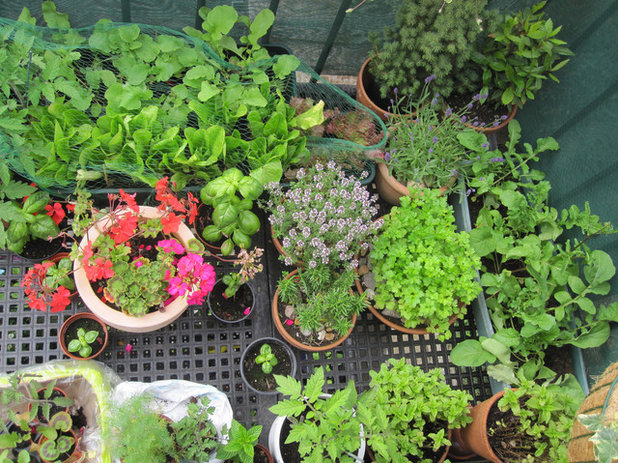 Why Grow Edibles on Your Patio or Deck
Why Grow Edibles on Your Patio or Deck- More light. Do you live in a cloudy region like the Pacific Northwest, where light is at a premium? Growing in an elevated space, where sun is easier to come by than at ground level, can be a great approach.
- Fewer pests. Pests like slugs, snails and even rats and squirrels are less likely to find your garden if it’s on a deck, especially if you’re in a high-rise.
- Fewer weeds. By growing in a potting medium that’s free of weed seeds, you’ll likely experience fewer weeds than backyard gardeners. Just don’t be surprised if a few weeds make it to your garden on the wind.
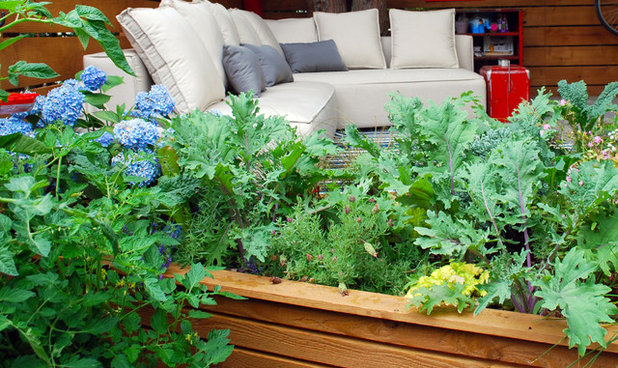
Mark S. Garff, Landscape Architect
- Less water use. Although container-grown veggies need more frequent watering than those grown in raised beds, it’s often easier to gauge how much water is needed, saving water in the long run.
- Easy access. Even if you grow most of your crops in raised beds, you can always keep a few containers of herbs on the deck right outside the kitchen. The convenience of walking out the door and snipping a few chives truly adds to the everyday cooking experience.
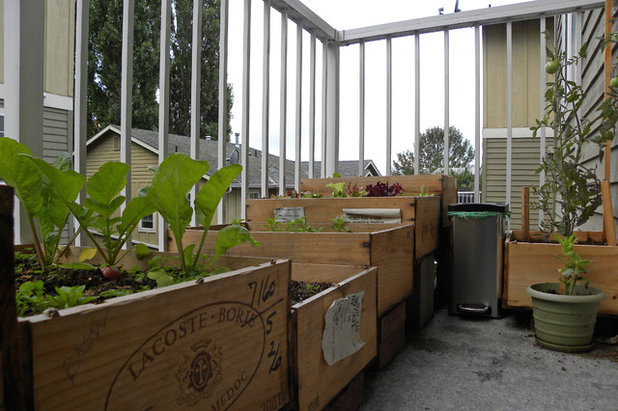
Sarah Greenman
How to Plan Your Patio or Deck Garden- Get good containers. The bigger the container, the better: Larger containers retain water longer and allow plants to develop stronger root systems. If you’re crafty or on a budget, consider upcycling materials like wine boxes or food storage totes with holes drilled in the bottom. Just make sure the wood hasn’t been treated and the container is food-safe. If you’re looking for a more elegant solution, consider cedar or fiberglass planters, which will last for years. Keep in mind that ceramic or terra-cotta planters, while attractive and inexpensive, can dry out quickly and crack in freezing temperatures. Make sure that your containers have adequate drainage holes.
- Get a good growing medium. Container gardens should always be planted in a specially designed potting mix. Unlike garden soil, potting mix is specially blended for moisture retention and is lightweight. Purchase the best-quality organic potting mix you can find, or mix your own. Look for a peat-moss-free potting mix, as peat moss is a nonrenewable resource. Vegetables are heavy feeders. Add a sprinkling of granulated slow-release organic fertilizer at the time of planting, and follow up with monthly additions of organic liquid fertilizer designed for vegetables.
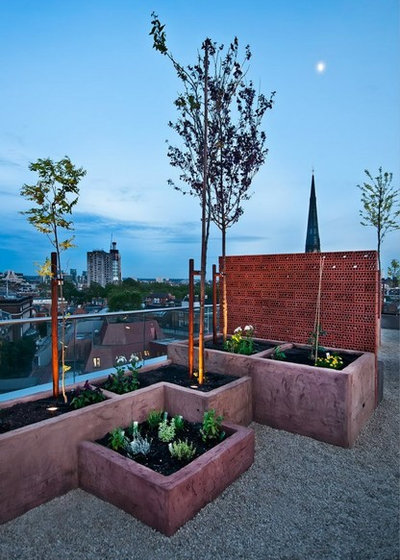
Urban Roof Gardens
- Protect plants from the elements. High-rise gardens can be vulnerable to wind, heavy rain and heat. Take advantage of existing structures like roof overhangs, patio umbrellas and glass railings to protect your plants. Consider using movable planters that can be relocated to a different part of your patio or deck as needed. To protect newly planted crops from storms, try using the clear plastic clamshell containers from commercial salad mixes. Alternately, you can construct mini garden hoops from sturdy wire and clear plastic. In the past, I’ve used bamboo to support my protective structures for containers, but this year I’ll be using 14-gauge galvanized wire to create mini hoops.
- Start worm composting. Want to make your own fertilizer? Consider setting up a worm compost bin. It’s a simple, nonsmelly way to recycle your kitchen scraps and create great fertilizer, and works well even in an apartment. You can harvest both worm compost and “worm tea” (liquid produced by the worm-composting process) to keep your plants healthy.
See more things to consider when planning your edible garden
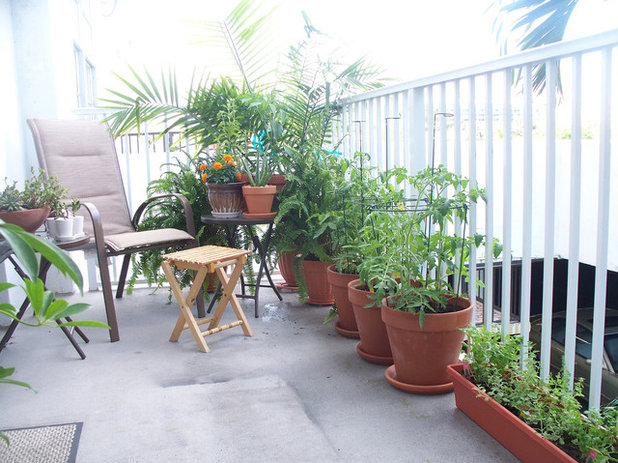 What to Grow on the Deck or Patio
What to Grow on the Deck or PatioWhile just about any vegetable or fruit can grow on a patio or deck, these classics are especially well-suited to container gardening.
Tomatoes. Tomatoes are a classic choice for container gardens. They soak up the heat of a patio or deck. Just be sure to use a container that’s at least 18 inches deep, and set up a trellis. See how to grow tomatoes
Potatoes. Believe it or not, potatoes grow beautifully in containers. Unlike those grown in the field, potatoes grown in containers don’t involve a ton of digging, searching and accidentally slicing spuds in half with your shovel to harvest. Instead, just tip the container onto a tarp when you’re ready. Use a large container or Grow Bag or another fabric container, and pile more potting mix on the plants are they grow. See how to grow potatoes
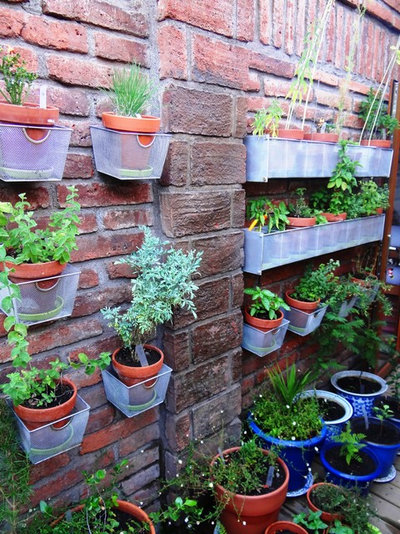
Carolina Katz + Paula Nuñez
Herbs. Herbs are an ideal choice for patio or deck gardens. By placing the plants close to your kitchen, you’ll always be inspired to pop outside and grab a few chives for dinner. Herbs do well in containers and appreciate the added sun and heat of a deck. What’s more, invasive plants like mint won’t have a chance to spread.
See how to grow 11 essential herbs
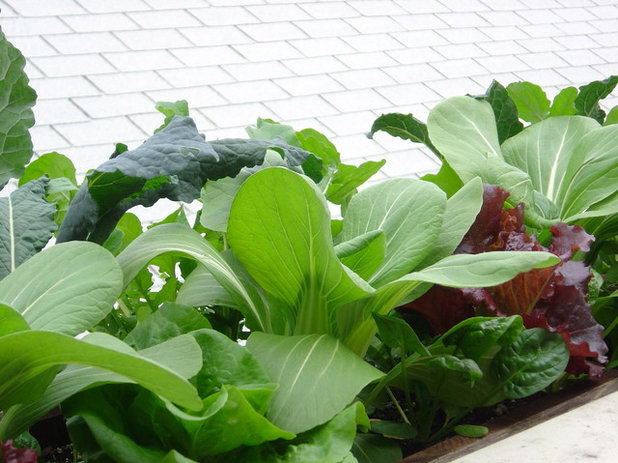
Steve Masley Consulting and Design
Salad greens. With their small root systems, salad greens do very well in containers. Thinly sow a small patch of seeds every week to keep a continuous supply, and be sure to harvest as soon as they look ready. By clipping salad greens with scissors, you can often get a second or even third harvest from one sowing. See how to grow salad greens
See more edibles that are easy to grow in containers
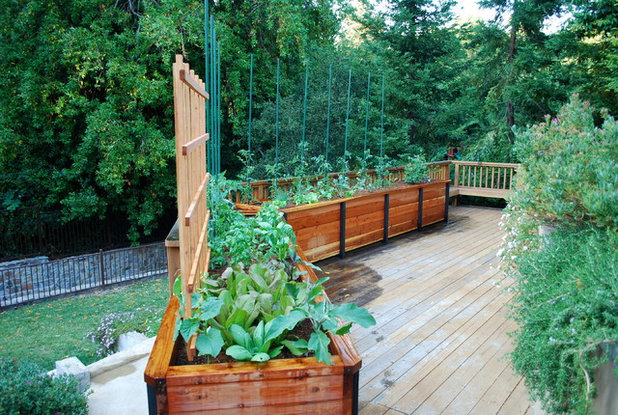
Steve Masley Consulting and Design
Things to Consider- Avoid overcrowding. Overcrowding is one of the most common reasons for crop failure in home gardens, especially when grown in containers. Compared to raised beds, plants grown in containers don’t have as much space to spread out their roots. Give large crops, like tomatoes, kale and cucumbers, lots of space with just one plant per large pot, one that’s at least 18 inches deep. Learn to sow the seeds of salad greens lightly, and thin excess seedlings relentlessly.
- Water regularly. Container-grown crops need more frequent watering than crops grown in raised beds. Make sure that your potting mix stays moist — like a freshly baked cake — but not soggy. It’s OK if the top dries out a bit in the afternoons, but everything underneath should stay nice and moist. In some cases, this will mean a daily or even twice-daily sprinkling. Early morning, before the midday sun heats things up, is the best time to water. If your life is busy, consider installing an irrigation system designed especially for containers, and set it on a timer.
- Maintain your soil. Vegetables are heavy feeders, as noted above. Add a sprinkling of granulated slow-release organic fertilizer at the time of planting, and follow up with monthly additions of an organic liquid fertilizer designed for vegetables.





